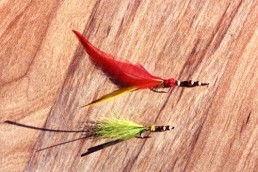Audible Flies: Meet the Click-Tink and Whirl Fly Patterns
SHARE THIS POST
Sight, smell and sound are all survival tools for fish, either for avoiding being eaten or finding something to eat. The majority of flies are tied and used based on their appearance. There are coatings such as a mayfly-smelling fly drying agent that can be used, but for the most part, because the nature of fly fishing is not based on smell, it is a nebulous technique at best. And then there is sound. Poppers are great for surface feeders, but don’t work well for deep fish.
To complete the arsenal of a fly fishing kit one must have something that attracts deep fish with sound.
We live in a noisy world, so we tend to ignore very quiet sounds. We are skeptical of things that make “noises” that we can’t hear. Hence, the dog whistle. When was the last time you heard one—oops—saw one being used? The lateral line of a fish includes a line of pressure “receptors” that go from gill to tail. This lateral line is really nothing more than a big ear, and the bigger the fish, the bigger the ear. A fish can hear the subtle vibrations both because of the sensitivity of the lateral lines and because of the density of water, which allows sound to travel farther and faster (about four times faster) than air.
The upshot of all this is that it doesn’t take much of a sound to get the attention of fish. The big-bladed spinner and
buzzbaits of the baitcaster have given the impression that sound has to be big and loud to be effective. There is no doubt that in some cases this is true, but delicate “whispers” have their place in fishing and the “click-tink” and “whirl fly” might fill the bill.
Are you enjoying this post?
You can be among the first to get the latest info on where to go, what to use and how to use it!
The idea for the fly came when I spilled a small sack of brass beads all over the basement floor. The multitude of little “tinks” made me think of crickets—the crickets made me think of tying flies and I thought: Why not add two or three beads to the shank instead of one and leave some room for the them to slide?
The tying is simple: Slide two or three metal beads onto the shank of the 3X or 4X hook. (A cricket hook also works.) I have also used glass or plastic beads to reduce the overall weight of the fly. Each type of material produces a unique sound, but I have not attempted to quantify the differences in efficacy of metal over glass or over plastic. If you want the first bead to stay stationary, wrap a ball of thread just behind the eye until the first bead just slides over it. Put a drop of cement on the ball of the thread and push the bead over it. In most cases, I just let the leading bead slide freely, as the eye is usually large enough to keep it from sliding off the hook. Move the other bead or beads next to the first and add your choice of dressing to the back half of the shank, leaving enough room on the shank for the beads to slide back and forth. The idea is that as you strip in line and pause, the fly will rise and fall, making the beads slide back and forth, “clicking” together. Perhaps it sounds like the chitin of insect legs or wings rubbing together, fins brushing against weeds or branches or maybe it just elicits a curious reaction from fish—whatever the reason, it does work.
A second way to not only add sound, but to also add some flash, is to put a spinner blade between two beads. I have found that less is more, so I use 0- or 1-sized blades; larger blades begin to interfere with casting. Tying is much the same as the bead fly. This time the order is bead-spinner-blade-bead-dressing. I use glass or plastic beads with the spinner to reduce weight. The second bead is larger to help hold the blade a little more perpendicular to the shank. Also, I’ll deduce the amount of dressing to keep the blade from hanging up on the material as it is retrieved. When I started tying this style of fly, I would tie one, attach a short piece of leader, and pull the fly though a bathtub of water to see what action the fly had. It took a few flies to get the technique down so that the blade spun as I thought it should. I should note, even if the blade doesn’t spin, there is still a lot of flash produced by the blade. Also, the stationary blade makes the fly move with an erratic motion.
Sometimes “matching-the-hatch” is what is needed while other times a different sense must be aroused, especially in stained or murky waters. So, make some flies that make some sound.
MWO
SHARE THIS POST
Did you enjoy this post?
You can be among the first to get the latest info on where to go, what to use and how to use it!
Doug Thalacker
Doug Thalacker has a Masters of Environment Science from UW-SP and taught high school environmental science and earth science. He has outdoor/wilderness training through Outward Bound and American Red Cross. He has a lifetime of enjoying any activity that involves fields, woods or waters.




